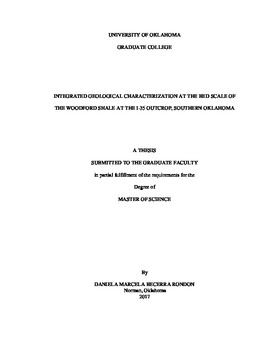| dc.description.abstract | A road-cut exposure located on the southern flank of the Arbuckle anticline along the Interstate-35 provided the opportunity to document in detail the lithological heterogeneities of the uppermost 81 feet of the Woodford Shale. This outcrop comprises portions of the middle and upper informal Woodford members. Lithologically, strata mostly consist of dark-colored, organic-rich mudrocks, which are rhythmically stacked into cm-scale cycles of ‘hard’ and ‘soft’ beds mimicking brittle-ductile couplets.
At the bed scale, based on weathering responses, the Woodford Shale is represented by two highly distinctive rock types: ‘soft’ and ‘hard’ beds. To document such typical high-frequency cyclicity, two samples were collected at every foot (one soft and one hard). In total, 157 samples were collected, from which a comprehensive multi-scale characterization was performed including several laboratory techniques: X-ray diffraction (XRD) for mineral composition, X-Ray fluorescence (XRF) for elemental composition and chemostratigraphy, total organic carbon (TOC) for organic richness, Rock-Eval pyrolysis for kerogen quality, thin sections and SEM for petrography, micro-rebound tests for rock hardness and uniaxial compressive strength tests (UCS) for mechanical properties. Laboratory results from this study corroborated the outcrop-based distinction between ‘soft’ and ‘hard’ beds, as determined by systematic contrasts in mineral/elemental composition, rock fabric and mechanical properties.
Experimentally, ‘Soft’ beds are ductile since they sustained more plastic deformation before failure; these beds are usually finely laminated, fissile, clay-rich (> 15 wt.%), and have very high TOC and organic proxies (Mo, U), low Si/Al ratios, and high detrital proxies (Ti, Zr, K, Al). Rock brittleness, UCS, Young’s modulus and hardness values are usually low for ‘soft’ beds. ‘Hard’ beds on the other hand are brittle since they sustained little to none plastic deformation before failure on lab experiments; these beds are massive, quartz-rich (> 90 wt. %), and have lower TOC contents and organic proxies (Mo, U), low detrital proxies (Ti, Zr, K, Al) and much higher UCS, Young’s modulus, brittleness and hardness values.
The high-resolution characterization results from this thesis provided insights for the prediction of rock properties for the two dominant and distinctive rock types within the Woodford Shale, ‘soft’ and ‘hard’ beds; giving rise to speculate that if proper physical distinction is made between ‘soft’ and ‘hard’ beds in cores or outcrops, few samples would work fine to upscale rock properties within larger intervals with incomplete sets of data, thus reducing costs/time related to acquiring large datasets from numerous analytical techniques.
Correlations between outcrop-based gamma-ray profiles and subsurface gamma-ray logs demonstrated good lateral and vertical continuity with systematic stacking patterns. Thus, outcrop-based rock characteristics can be projected into the subsurface to logs in un-cored wells to identify zones for optimum drilling and completion in the Woodford Shale and analog reservoirs. | en_US |
